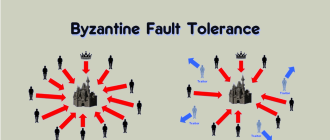Today, we delve into the Ethereum Virtual Machine (EVM), a pivotal technology at the heart of the Ethereum platform, which ranks as the second largest cryptocurrency by market capitalization, following Bitcoin. The EVM offers a powerful, flexible, and secure environment for executing smart contracts. These contracts automatically enforce the terms of agreements between different parties without the need for intermediaries. This section explores the architecture, technology, and application of the EVM, along with its history and development.

The Genesis and Evolution of the EVM
The EVM was conceptualized as part of the original Ethereum proposal put forth by Vitalik Buterin in 2013. Since its inception, the EVM has undergone numerous iterations and enhancements to evolve into the robust component it is today. From its initial concept to its current implementation, the EVM has remained a vital element in ensuring the execution and security of smart contracts on the Ethereum platform.
Functionality of the EVM
The Ethereum Virtual Machine (EVM) is a critical component of the Ethereum platform, acting as a completely isolated runtime environment. In this environment, transactions and smart contracts are processed and executed. Functioning as a global supercomputer, the EVM enables developers to create decentralized applications (dApps) that can operate on millions of connected devices worldwide. This architecture not only supports the decentralized nature of the platform but also enhances its scalability and security, empowering a vast array of applications across various sectors.
Technical Specifications of the Ethereum Virtual Machine (EVM)
The EVM is more than just an execution environment; it’s a complex system designed for the reliable and secure execution of smart contract code. Below are the key technological aspects and unique characteristics of the EVM:
Isolated Execution Environment
The EVM functions as a fully isolated virtual machine, meaning that the code running inside the EVM does not have direct access to the files or processes of the host system. This isolation is crucial for security, as it prevents potential attack vectors through smart contracts that could compromise user data or the blockchain network itself.
Data Storage System
The EVM employs three primary types of data storage: stack, memory, and storage. The stack is a Last In, First Out (LIFO) data structure used to store parameters and partial results of operations. Memory is a temporary storage area for carrying out operations and maintaining state within a single transaction. Storage, on the other hand, is used for recording states that must be preserved between individual transactions. This mechanism allows smart contracts to maintain and interact with state over time.
Opcode Table
The EVM executes bytecode that is translated from high-level languages such as Solidity. Each operation in the bytecode is represented by an opcode—low-level instructions that the EVM can recognize and execute. Opcodes cover a range of functionalities including mathematical operations, logical operations, memory access control, calls to other contracts, and execution control. The diversity and power of the EVM’s opcode set enable the implementation of complex logical constructs and algorithms in smart contracts.
Gas Mechanism
Each operation in the EVM has a certain gas cost associated with it, which must be paid to execute the operation. This mechanism prevents the abuse of network resources and infinite loops in the code. Gas provides an economic balance, making denial-of-service attacks economically unfeasible for attackers.
Universality and Hardware Independence
A distinctive feature of the EVM is its universality and independence from specific hardware configurations. This allows developers to create applications that can operate anywhere within the Ethereum network without the need for adaptation to different types of devices or operating systems. The EVM also supports the creation of decentralized applications (dApps) that can interact with other smart contracts and blockchains, broadening the possibilities for integration and collaboration between various projects and platforms.
These technical features make the EVM a powerful tool for implementing a wide spectrum of decentralized applications, providing developers with flexibility, security, and scalability in the creation of new digital services and products.
Programming Languages for the Ethereum Virtual Machine (EVM)
Programming languages for creating smart contracts on the Ethereum Virtual Machine (EVM) are vital in shaping the structure, security, and functionality of decentralized applications. Solidity and Vyper are the most prominent languages used with the EVM, each offering unique features tailored to different aspects of smart contract development.
Solidity
Solidity is a high-level, object-oriented programming language designed specifically for developing and implementing smart contracts on blockchain platforms like Ethereum. Its syntax, reminiscent of JavaScript, makes it accessible to a wide range of developers.
Technical Features of Solidity:
- Static Typing: Solidity’s static typing helps catch errors during compilation rather than at runtime, reducing the likelihood of critical failures in smart contracts.
- Inheritance and Interfaces: Support for object-oriented concepts like inheritance and interfaces allows the creation of complex hierarchical structures within contracts, facilitating code organization and component reusability.
Unique Features:
- Smart Property Management and Automatic Getters: Solidity integrates advanced features such as smart property management and automatic getters for public variables, simplifying development and enhancing the transparency of contract operations.
Vyper
Vyper is a programming language developed with a focus on security and simplicity. It eschews some of Solidity’s capabilities in favor of reducing the risk of errors and vulnerabilities.
Technical Features of Vyper:
- Transparency and Security: Vyper does not support modifiers, inheritance, or other features that could obscure potentially dangerous actions, aiming for code to be as transparent and predictable as possible.
- Limited Function Set: Vyper excludes constructs like indefinite loops and recursion, thereby preventing certain types of attacks related to gas exhaustion.
Unique Features:
- Auditability: Vyper focuses on creating code that is easier to audit for errors and vulnerabilities, which is crucial for financial applications and other scenarios where security is paramount.
These programming languages provide developers with tools to finely tune the logic and behavior of smart contracts, ensuring they perform needed functions while adhering to stringent security standards.
Security on the Ethereum Virtual Machine (EVM)
Security within the Ethereum Virtual Machine (EVM) is built on a series of embedded mechanisms and practices, each playing a crucial role in ensuring the reliability and stability of smart contracts. Let’s delve into these mechanisms in detail and explore their advantages and disadvantages.
Security Mechanisms of the EVM
- Isolated Execution: Each smart contract on the EVM is executed within an isolated environment, which prevents it from interacting with other contracts and the host system, except through well-defined interfaces. This isolation helps safeguard against unauthorized access and ensures that contracts cannot inadvertently affect each other.
- Gas Limitation: Every operation in a smart contract incurs a cost in gas, which prevents infinite loops and extensive code execution that could lead to service denial attacks. This mechanism not only protects the network but also encourages developers to write efficient code to stay within gas limits.
- Static Typing (Used in Languages like Solidity): Languages for the EVM employ strict typing, which helps prevent a range of errors during compilation. This reduces the chances of bugs and vulnerabilities in the deployed smart contracts, enhancing overall security.
Implications for Developers
Each of these security mechanisms not only adds a layer of protection but also defines how developers should approach smart contract creation. For instance, the gas limitation requires developers to meticulously plan contract logic to fit within the provided limits. This necessitates a deeper understanding of how the EVM operates and demands code optimization skills.
Advantages and Disadvantages
Advantages
- Enhanced Security: The built-in security features such as isolated execution and static typing significantly reduce the risk of malicious exploits and operational failures.
- Encouraged Efficiency: Gas limits compel developers to optimize their code, which can lead to more efficient and economically designed applications.
Disadvantages
- Complexity in Development: The stringent requirements and limitations imposed by EVM security mechanisms can increase the complexity of smart contract development.
- Potential for Overhead and Limitations: Strict gas calculations and isolated execution environments can sometimes restrict the flexibility and scalability of applications, especially those requiring complex or extensive computations.
These mechanisms collectively create a stringent yet flexible environment for the development and execution of smart contracts, making the EVM one of the most secure platforms for the development of decentralized applications.
Projects Based on the Capabilities of the Ethereum Virtual Machine (EVM)
The Ethereum Virtual Machine (EVM) supports a vast array of decentralized applications (dApps), showcasing the potential of blockchain technology across various domains. Here are some key projects operating on the EVM:
DeFi (Decentralized Finance)
- Examples: Uniswap, Maker, Compound
- Functionality: These platforms facilitate cryptocurrency exchanges, loans, and lending through automated mechanisms like the liquidity pools maintained by Uniswap’s Automated Market Makers (AMMs).
Games and Collectibles
- Examples: CryptoKitties, Axie Infinity
- Functionality: These applications use blockchain to authenticate ownership of unique digital assets, such as Non-Fungible Tokens (NFTs), enabling a new form of digital collectibles and interactive gaming experiences.
Decentralized Autonomous Organizations (DAO)
- Examples: Aragon, DAOstack
- Functionality: Utilize smart contracts to create and manage organizations where decisions are made through participant voting, democratizing organizational governance.
Identification and Authentication
- Examples: Galxe, Civic
- Functionality: Allow users to control their personal data and manage their digital identities while maintaining privacy. These platforms provide secure, verifiable identity solutions which are increasingly critical in digital interactions.
Predictive Markets and Betting
- Examples: Augur, Gnosis
- Functionality: Establish decentralized markets for betting on the outcomes of events, where results are determined through community consensus.
These projects highlight the flexibility and power of the EVM in implementing a diverse range of decentralized solutions, from finance and gaming to identity management and social platforms, ensuring safe and efficient blockchain-based interactions.
Optimization and Scalability of Ethereum
To enhance performance and scalability, Ethereum has implemented key initiatives such as transitioning to a Proof of Stake (PoS) consensus mechanism and adopting second-layer solutions.
Transition to Proof of Stake (PoS)
Ethereum 2.0 includes a shift from Proof of Work (PoW) to Proof of Stake, significantly improving the network’s efficiency and sustainability.
Technical Details
In PoS, validators, not miners, are responsible for confirming transactions and creating new blocks, requiring significantly less energy. Validators are chosen based on the amount of their ETH stakes, reducing the likelihood of centralization and increasing network security.
Role of PoS
This transition aims to reduce energy consumption and speed up transactions, making the network more attractive for a wide range of applications and scalable.
Second-Layer Solutions
Ethereum is actively developing second-layer technologies to enhance scalability and performance, including State Channels and Rollups.
State Channels
- Description: Allow transactions to be performed off the main blockchain network, with final confirmation on the blockchain once all operations are completed.
- Example: The Raiden Network, which facilitates fast and cost-effective transactions, similar to Bitcoin’s Lightning Network.
Rollups
Rollups process transactions off the main chain while keeping data on the blockchain to ensure security.
- Optimism: Implements Optimistic Rollups, which assume transactions are valid by default with a period for disputes. This speeds up processing while maintaining auditability.
- Arbitrum: Uses enhanced Optimistic Rollups for more efficient and secure transaction processing, reducing the wait time for finalization.
- ZK-Rollups: Includes projects like zkSync that use zero-knowledge proofs for fast and private transaction processing.
These technologies significantly increase Ethereum’s throughput, allowing the network to scale effectively and handle a larger volume of transactions. Such solutions make Ethereum a more attractive platform for large-scale applications requiring high throughput, such as financial operations and microtransactions.
Conclusion
The EVM remains a central pillar in the Ethereum ecosystem, providing developers with powerful tools for creating and executing smart contracts. Ongoing improvements and updates promise even greater optimization and scalability in the future, solidifying Ethereum’s position as a leading platform for decentralized applications.







